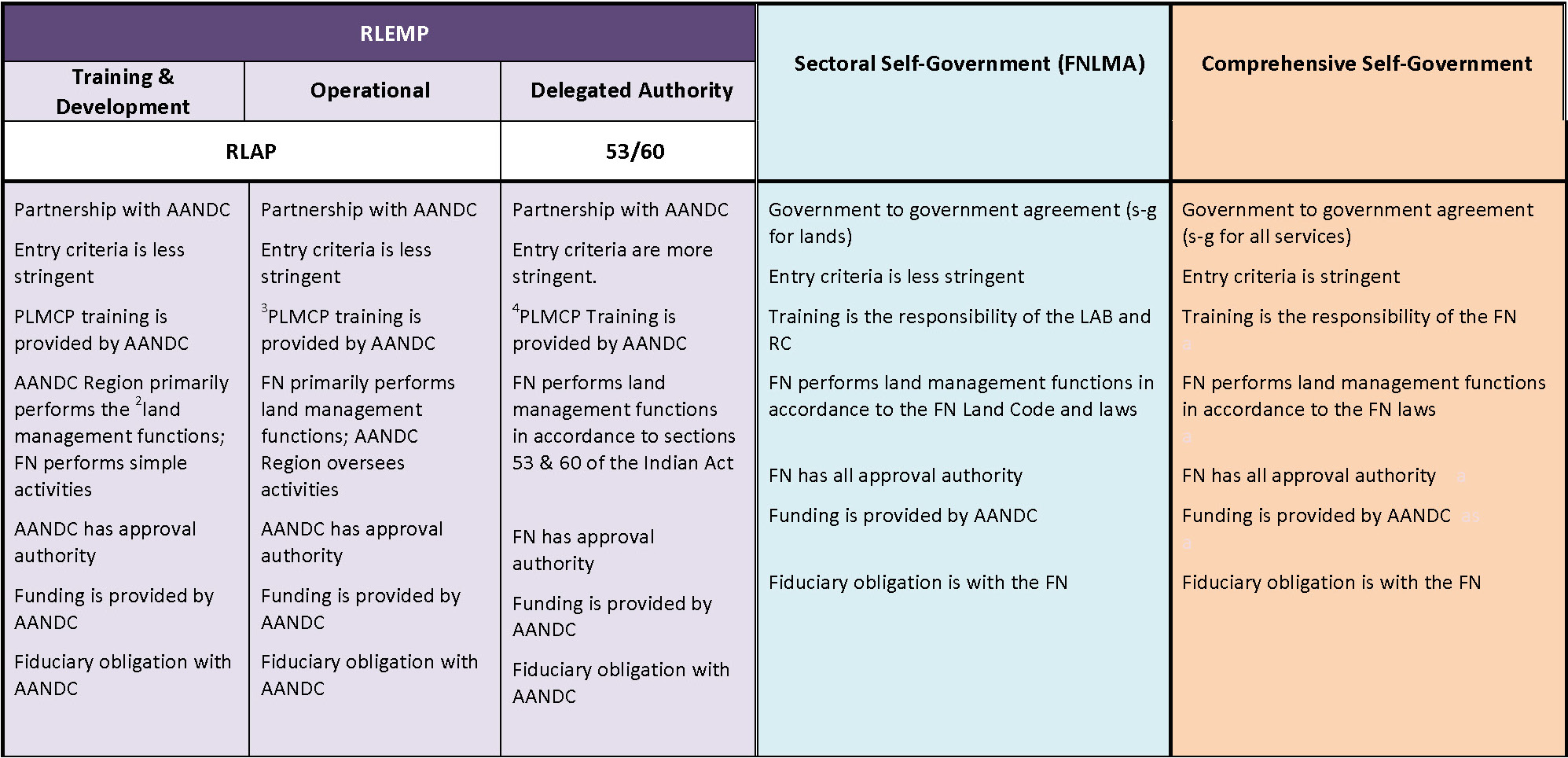New Addition to this page
Did you know that there are only 3 land regimes for all of the 618 First Nations across Canada. Take a look at the following document to familiarize yourself with all you need to know about the land regimes.
RLEMP Structure
RLEMP is currently structured so that First Nations can function at either of two levels of increasing responsibility, complexity and independence, namely the Training and Development Level and the Operational Level. These levels of responsibility are based on:
- The activities to be performed by the First Nation land manager and or regional staff at each level.
- Land management competency assets, such as knowledge skills and abilities for the First Nation land manager.
- The amount and complexity of land management activity for the First Nation.
- The experience requirements for the First Nation land manager at each level.
The RLEMP is focused on enabling the First Nations to become involved in a broader spectrum of activities pursuant to the Indian Act. The key functions are:
- Community Land Use Planning
- Management of reserve land and natural resources
- Environment management
- Compliance policy and legislative frameworks
The Mohawk Council of Kanehsatake is currently under the Operational Level of RLEMP.
Kanehsatake’s land’s manager is responsible for all land management activities following applicable legislation, departmental policies and operational guidelines (eg. Land Management Manual) to manage on-reserve activities up to the point of ministerial consent, and thus the following activities are part of the Land Manager’s responsibilities:
- Retaining a PLMCP (Professional Land Management Certification Program) Certified Land Manager.
- Maintaining an established Lands Office.
- Negotiating and drafting land instruments (e.g. Leases, permits, BCR allotments, individual land holding etc.).
- Confirming that survey requirement are met.
- Ensuring that appraisals are conducted as necessary.
- Entering the transaction particulars
- Preparing reports and having them approved.
- Preparing Land Transaction Information Report (land status report, encumbrance check).
- Preparing Land Transaction Checklist to confirm registration requirement have been met.
- Preparing Locatee Consents.
- Managing environmental management processes associated with each of the RLEMP key functions and providing reports for review and approval by INAC region.
- Completing registration packages and forwarding transaction to INAC region for approval.
- Receiving registration particulars from INAC region and sending executed documents to proponents, retaining a copy on file.
- Monitoring and compliance: Conducting compliance related activities associated with land and natural resources transactions
- Providing report (s) as per requirements in the INAC funding agreement.
- Remaining compliant with terms and conditions for RLEMP eligibility
IMPORTANT NOTE: REGARDLESS OF THE RESPONSIBILITY TAKEN ON BY THE FIRST NATION, LIABILITY FOR LAND TRANSACTIONS REMAINS WITH THE MINISTER OF INAC.
**Kanehsatake is under the Kanehsatake Land Governance Act, therefore assumes land governance according to the land code.
Land transactions become the liability of the First Nation.
Please see the LGA Tab

Following Land Regimes Defined
Kanesatake is currently RLEMP Operational phase
The most important difference is the fiduciary obligation that carries responsibility for liability.
- In the case of RLEMP, INAC retains that fiduciary obligation over reserve lands.
- Under the Framework Agreement of FNLM with a land code, and under a comprehensive self-government; First Nations will be responsible for decisions they make after a land code was enacted, whereas Canada continues to be responsible for all acts and omissions before a land code was enacted.
RESERVE LAND & ENVIRONMENT MANAGEMENT
The RLEMP provides financial support to First Nation communities, First Nation institutions and professional development organizations for services associated with Indian Act land and environmental management services.
The RLEMP is a comprehensive and integrated land, resource and environment management program designed to succeed and expand upon the Regional Land Administration Program (RLAP) and to incorporate the 53/60 Delegated Authority program.
The RLEMP is expected to enhance decision-making at the community level in regards to land use and increase the capacity of First Nations. As a result, the community will be able to take advantage of land-based economic development opportunities on reserve and to facilitate a First Nation community’s transition beyond the Indian Act into more sophisticated land management regimes such as the First Nations Land Management (FNLM) regime or comprehensive self-government.
https://www.aadnc-aandc.gc.ca/eng/1399305895503/1399306034289
NOTE ON THE BELOW TWO LAND REGIMES
Kanesatake cannot enter those two land regimes because they are not a reserve under the definition of the Indian Act
FRAMEWORK AGREEMENT OF FIRST NATIONS LAND MANAGEMENT
The Framework Agreement is an initiative by these original signatory First Nations to opt out of the land management sections of the Indian Act and take over responsibility for the management and control of their reserve lands and resources. The Framework Agreement sets out the principal components of this new land management process.
https://labrc.com/wp-content/uploads/2016/08/FA-current-to-2013.pdf
COMPREHENSIVE SELF GOVERNMENT
Self-government agreements are one means of building sound governance and institutional capacity that allow Aboriginal communities to contribute to, and participate in, the decisions that affect their lives and carry out effective relationships with other governments.
https://www.rcaanc-cirnac.gc.ca/eng/1100100032275/1529354547314